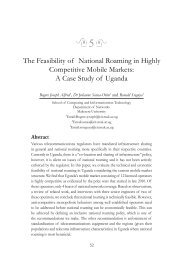Undergraduate Handbook - School of Computing and Informatics ...
Undergraduate Handbook - School of Computing and Informatics ...
Undergraduate Handbook - School of Computing and Informatics ...
You also want an ePaper? Increase the reach of your titles
YUMPU automatically turns print PDFs into web optimized ePapers that Google loves.
Indicative Content: This course presents assembly language programming as the bridge between hardware <strong>and</strong><br />
high-level programming languages such as C++. Topics covered include the addressing modes, register file, <strong>and</strong><br />
instruction set <strong>of</strong> a microcontroller; subsystems such as timers, h<strong>and</strong>shaking input <strong>and</strong> output, <strong>and</strong> analog to digital<br />
conversion; <strong>and</strong> interrupts. S<strong>of</strong>tware control <strong>of</strong> hardware is stressed. In the laboratory, students design s<strong>of</strong>tware to<br />
demonstrate pr<strong>of</strong>iciency in these areas. Introduction to microcomputer/microcontroller structure from a<br />
programmers perspective; 68hc11 addressing modes <strong>and</strong> memory types; Tool usage (assembler, linker, downloader,<br />
simulator); 68hc11 instruction set (5 classes) Assembly language Programmes structure, including comparisons to<br />
high level languages; Parallel I/O with h<strong>and</strong>shaking; Analog I/O on the 68hc11 plus background on A/D <strong>and</strong> D/A<br />
converters; Hardware interrupts.<br />
Reference Book:<br />
i. S. A. Edwards, Languages for Digital Embedded Systems, Kluwer Academic Press, 2000.<br />
BSE 2302: Pr<strong>of</strong>essional S<strong>of</strong>tware Engineering Mini Practical Project II (4 CU)<br />
Course Description: Upon successful completion <strong>of</strong> the course, the student should: Demonstrate mastery <strong>of</strong> a<br />
specific programming language <strong>and</strong> development platform; Carry out requirement engineering for a particular<br />
project; <strong>and</strong> demonstrate ability to develop a mini application or systems with minimal difficulty.<br />
Indicative Content: An introduction to a specific pr<strong>of</strong>essional s<strong>of</strong>tware certification course is covered.<br />
Reference Books:<br />
i. A. Koenig <strong>and</strong> B. E. Moo, Accelerated C++: Practical Programming by Example, Addison-Wesley, 2008.<br />
ii. J. Friesen, Beginning Java SE 6 Platform: From Novice to Pr<strong>of</strong>essional, Apress October 2007.<br />
iii. S. Karam, <strong>and</strong> R. Freeman, Easy Oracle Jumpstart: Oracle Database Management Concepts <strong>and</strong><br />
Administration.<br />
iv. S. Feuerstein, B. Pribyl <strong>and</strong> C. Dawes, Oracle PL/SQL Language Pocket Reference, 4th edition, O’Reilly<br />
2007.<br />
BSE 3101: IT Project Management <strong>and</strong> Development (4 CU)<br />
Course Description: At the end <strong>of</strong> the course, students will: Appreciate the range <strong>of</strong> practical project management<br />
techniques available; be able to apply project management principles <strong>and</strong> techniques within their organizations; <strong>and</strong><br />
be able to confidently undertake the management <strong>of</strong> a project <strong>and</strong> see it to a satisfactory conclusion on time <strong>and</strong><br />
within budget.<br />
Indicative Content:<br />
• Integration Management includes the processes required to ensure that the various elements <strong>of</strong> the project<br />
are properly co-coordinated.<br />
• Scope Management is the function <strong>of</strong> controlling a project in terms <strong>of</strong> its aims, goals <strong>and</strong> objectives<br />
through the process <strong>of</strong> conceptual development, full scope definition or statement, scope reporting <strong>and</strong><br />
control, <strong>and</strong> project close out.<br />
• Time Management is the function <strong>of</strong> maintaining appropriate allocation <strong>of</strong> time to every element in the<br />
overall conduct <strong>of</strong> the project through the successive stages <strong>of</strong> its natural life-cycle.<br />
• Cost Management is the function <strong>of</strong> maintaining effective financial control <strong>of</strong> the project.<br />
• Quality Management is the composite <strong>of</strong> material attributes (including performance features <strong>and</strong><br />
characteristics) <strong>of</strong> the product or service which are required to satisfy the needs for which the project is<br />
being undertaken.<br />
• Human Resource Management is the function <strong>of</strong> directing <strong>and</strong> coordinating human resources throughout<br />
the life <strong>of</strong> the project. It involves the application <strong>of</strong> the principles <strong>of</strong> behavioral science <strong>and</strong> administrative<br />
knowledge to achieve the predetermined project objectives <strong>of</strong> scope, time, cost, quality <strong>and</strong> participant<br />
satisfaction.<br />
114

















